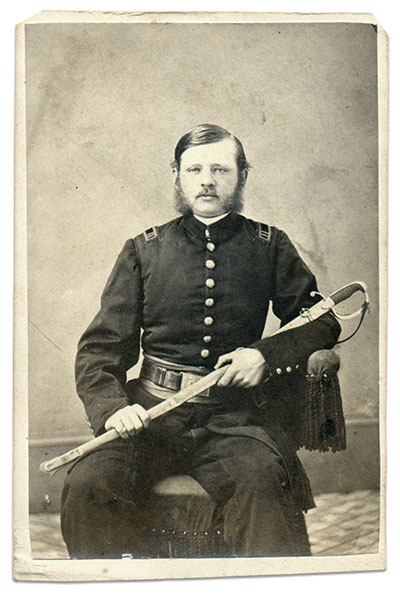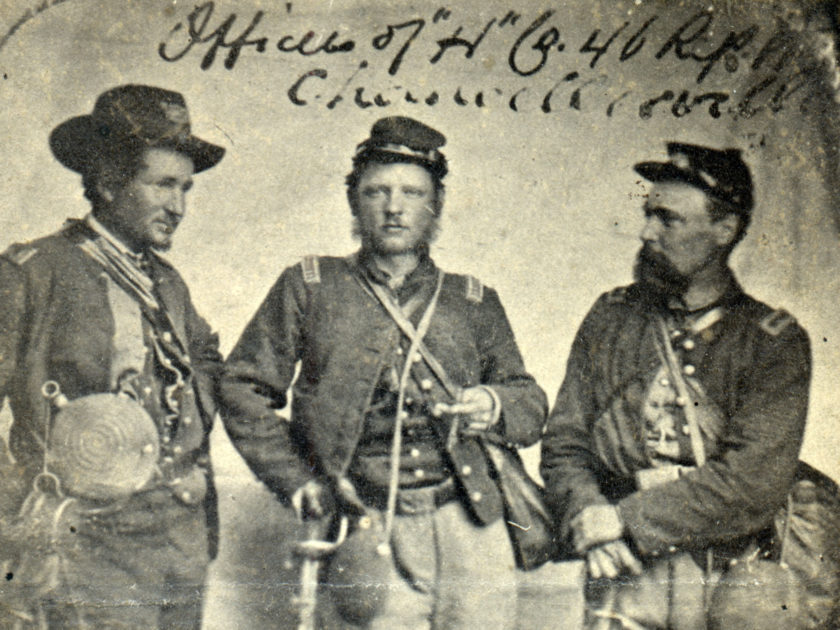By Ben Myers
If Lt. Alexander W. Selfridge had a moment to take in what was about to happen to his company, it was probably fleeting.
Perhaps he noticed that the rifle fire to his front was stronger than expected, or that artillery fire rained in from his far left, lobbing shells from the slopes of a small mountain. They rushed forward, a wall of blue almost 2,000 strong armed with glimmering bayonets, and drenched in the sweat wrought by a nearly 100 degree summer day. Yet, Selfridge, just 18 years old and in command of Company H of the 46th Pennsylvania Infantry, probably thought of little else other than simply to “keep going.” He likely didn’t even notice when the advancing wave of soldiers— Crawford’s Brigade—occasionally left a mangled and slouched over body behind it. He just had to keep moving toward the wood-line before him.

All too soon, they were on it, trying to scramble over a rail fence. Selfridge hoisted himself over it and into the foliage. Some of his boys, however, weren’t as fortunate. He yelled as loud as possible, waving his sword, hoping his men would follow. Bullets tore all around him, ripping the leaves off of trees and furiously ricocheting from stumps. Perhaps here, he realized they were really in for it.
The woods were thick with the enemy, Stonewall Jackson’s boys. But some of the newer gray-clad regiments had grown shaky, and buckled before so many federals rushing at them. As rebel ranks gave way, the woods became a jumble of regiments. Without the time to load rifles, soldiers fought with what they could: bayonets, swords, clubbed muskets, revolvers, rocks and hands. If Selfridge remembered what he did in those woods, he most likely never spoke of it.
Crawford’s men rolled up the Confederate line with surprising ferociousness, leaving dead, wounded and prisoners in their wake. Somehow, Selfridge found himself boxed in, and, lacking any other options, threw his hands up in surrender. As his men pushed onward, he was left behind.

In the battle of Cedar Mountain, Selfridge’s 46th, along with its sister regiments in Crawford’s Brigade, suffered 50 percent casualties during the charge. They had destroyed Stonewall Jackson’s line, but ultimately lost the day for want of reinforcements. Selfridge was counted as missing, written down as captured.
The rebels shipped off Selfridge to Libby Prison in Richmond. It wasn’t the first time he had been there. In May, he had fallen into enemy hands during Union Gen. Nathaniel Banks’ embarrassing retreat down the Shenandoah Valley. The affair had left countless federal supplies in Confederate hands, earning the general the nickname “Commissary Banks.” The loss altered Union strategy outside of Richmond, which ultimately resulted in the failure of the Peninsula Campaign. Selfridge had a short stay in rebel hands that time, but the beginning of his second stay almost went terribly wrong. Some of the guards recognized him, and, he recalled, “the rumors was spread amongst them that I had violated my parole, when the ragged and ferocious rabble denounced me and threatened to hang the Yankee and Abolitionist. So it continued until several hundred had collected together to see ‘that fellow hung!’” Fortunately for Selfridge, some ranking officers felt due diligence was in order, and removed him from the mob for questioning.
After explaining his circumstances, Selfridge was deemed to have not violated his parole, and held for a little over a month in one of Libby’s infamous rooms, “covered with filth, vermin, [and] a horrid stench [that] pervaded the whole.” Selfridge was released on September 25th and returned to the skeleton ranks of the 46th, which, in addition to their ordeal at Cedar Mountain, would lose even more men at Second Manassas and the Battle of Antietam.

The regiment didn’t see action again until the following spring, when it entrenched outside a Virginia hamlet called Chancellorsville. On May 2, the men were ordered to leave the safety of their defenses, only to have their order rescinded after traveling a short distance. Moving his men back to the trench-line at the double quick, Selfridge remembered they “heard a racket on our right, which turned out to be Jackson’s famous charge upon the 11th Corps.”
Soon, Selfridge’s company, moving as quickly as it could through dense underbrush, found itself surrounded by fleeing 11th Corps soldiers. The seriousness of the situation began to sink in when they arrived back at the trench line, along with the rest of the regiment, only to find it filled with rebels. Halting about 40 feet from the works, a Confederate yelled out “Surrender, ye Yankee —!” The major of the 46th, Cyrus Strouse, in command of the regiment, drew his revolver and fired. Rifle fire erupted. Strouse fell mortally wounded, and the Pennsylvanians broke for the rear.
That evening, with Jackson’s momentum broken, the woods surrounding the Plank Road turned into a mishmash of mixed units. Selfridge and Company H tried to determine the location of the enemy when movement was detected to their front. “We advanced but a few yards when we heard voices and saw the dim outline of horsemen, riding about,” recalled Selfridge. “One of my men said it was too good a chance to shoot at a staff of officers to let it slip, and fired. The rest of my men instantly blazed away at them.”
Moments later, Selfridge recalled a Confederate unit — probably the 18th North Carolina Infantry—on the opposite side of the horsemen, also firing a volley. More rounds were let loose from behind the 46th. After learning of Stonewall Jackson’s wounding in the area, Selfridge and his men became nearly convinced that they had unleashed the volley that felled Jackson.
“The seriousness of the situation began to sink in when they arrived back at the trench line, along with the rest of the regiment, only to find it filled with rebels. Halting about 40 feet from the works, a Confederate yelled out “Surrender, ye Yankee —!”
A few days later, the young captain and two of his lieutenants, Orlando J. Rees and Merrick Jackson, posed for a photo. Their brash confidence is almost palpable. Selfridge leans on his sword and coolly holds a cigar, staring forward with blue eyes that had witnessed the fury of battle for the third time. This time, though, he was pretty sure his boys had been the ones that took down Jackson, who had caused his regiment so much grief and more than halved their ranks in a year. His cockiness is probably well deserved. History, of course, has proved that it wasn’t Selfridge’s men who shot Stonewall. Yet, they undoubtedly wanted to believe they had delivered the fatal shot.
After Chancellorsville, Selfridge, Company H and the 46th participated in grueling forced marches, chasing Gen. Robert E. Lee’s army as it invaded Pennsylvania. On the night of July 1, 1863, the regiment arrived at Culp’s Hill near Spangler’s Spring, and started digging breast works along its crest. The next afternoon, the entire division was ordered out of its trenches to support the opposite flank of the battle, but arrived too late to be of assistance.
Returning to the right flank, the division stopped a short distance from their fortifications and waited for orders. Thirsty from their exertions on yet another hot summer day, each company sent a man off to fill canteens. Selfridge took some of his men’s canteens and made his way in the dark to Spangler’s Spring. Kneeling at the edge of the cool stream of water, he started filling a canteen when he noticed the shadows of soldiers across the stream from him doing the same. He realized they were Confederates. Having twice done his time as a prisoner, Selfridge backed out of the area as quietly as he could, and informed his colonel of the enemy’s presence.
Not expecting to find the enemy down by the spring, skirmishers sent forward soon realized that, in their absence, the Confederates had taken their trench line. Ineffectual maneuvering and skirmishing ensued, and orders arrived to wait and retake the trenches at daybreak.
On the morning of July 3, the 46th repelled waves of Confederates that surged up the side of Culp’s Hill. They held the right flank of the Union line steady through almost seven hours of fighting. By the end of the day, Lee’s invasion had failed, and his troops turned south. They would never again set foot on Northern soil.
A long and grueling war still lay ahead for Selfridge and the 46th. Transferred to Tennessee in the fall of 1863, they re-enlisted in the winter of 1864, and joined the Atlanta Campaign. Selfridge led Company H through the vicious fighting around Atlanta, including the battle of Peachtree Creek, where the regiment again suffered 50 percent casualties. He was then detached from the regiment to serve as Brigade Commissary, and then as a provost marshal through Sherman’s March to the Sea and the Carolinas Campaign. After Lee and Johnston’s surrender in April 1865, the 46th returned to Washington, D.C., and participated in the Grand Review. They mustered out in July, and Selfridge, now 21, went home a breveted major for his war service.
Selfridge returned to Bethlehem, Pa., and resumed his job as a bookkeeper for a coal company. He married Kate Riggins in 1871. Three children followed — a son, Alexander, the same year, a daughter, Jessie, in 1872, and another daughter, Kate, in 1876. By 1880, he was working as a coal agent, and the small family had the means to afford a servant.
Selfridge’s family life however, was short lived. Around 1891, he relocated to Philadelphia after divorcing his wife. More personal tragedy followed with the deaths of his son in 1895, and his eldest daughter in 1896.
Health issues plagued Selfridge in later years. He applied for a veteran’s pension at age 48 in the early 1890s, stating he was unable to earn a living due to poor eyesight and “sciatic rheumatism,” arthritis in the lower back, hips and legs that could cause crippling numbness. By 1903, he added lumbago (lower back pain), vertigo and heart disease to his list of health issues. Like many other veterans, the countless miles of marching and poor rations during his Civil War service had taken a toll on his body, and no doubt contributed to his ailments.
He worked as a bookkeeper, and later as a storekeeper, until he could no longer get around. He spent the last few years of his life confined to his room.
Selfridge died on July 11, 1922, and was buried in Nisky Hill Cemetery in Bethlehem, Pa.
Special thanks to Vic Selfridge and Jim McCoy for research assistance. For more information on the 46th Pennsylvania Infantry, visit fortysixthregiment.org.
References: Personal correspondence of Major Alexander W. Selfridge; William C. King, Campfire Sketches and Battle-Field Echoes; Alexander W. Selfridge pension file, National Archives, Washington, D.C.; Pennsylvania at Gettysburg: Ceremonies at the dedication of the monuments erected by the commonwealth of Pennsylvania to mark the positions of the Pennsylvania command engaged in the battle; 1880, 1900 U.S. Census.
Ben Myers is a web developer in Washington, DC. A descendent of the 46th Pennsylvania Infantry, he spends his free time researching the regiment. When separated from a computer, he enjoys travel and hiking.
SPREAD THE WORD: We encourage you to share this story on social media and elsewhere to educate and raise awareness. If you wish to use any image on this page for another purpose, please request permission.
LEARN MORE about Military Images, America’s only magazine dedicated to showcasing, interpreting and preserving Civil War portrait photography.
VISIT OUR STORE to subscribe, renew a subscription, and more.

